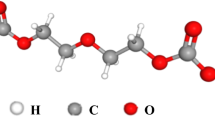Abstract
Ion irradiation with various oxygen flow rates has been carried out to improve the wettability of polymethylmethacrylate (PMMA) to water and to enhance the adhesion between Al and the polymer. Ar+ ion and oxygen ion were irradiated on the polymer, and amounts of ions were changed from 5 X 1014 Ar+/cm2 to 5 X 1016 Ar+/cm2 by a broad ion beam source. Oxygen gas from 0 ml/min to 7 ml/min was flowed near the polymer surface during the ion irradiation, and the energy of ions was changed from 500 eV to 1500 eV. The wetting angle was reduced from 68° to 49° with the Ar+ ion irradiation only at 1 keV energy, to 43° with the oxygen ion irradiation, and dropped to 8° with Ar+ ion irradiation with flowing 4 ml/min oxygen gas near the polymer surface. Changes of wetting angle with oxygen gas and Ar+ ion irradiation were explained by a two-step chemical reaction among polymer matrix, energetic ions, and oxygen gas. The effects of Ar+ ion and oxygen ion irradiation were explained by considering formation of hydrophilic groups due to a reaction between irradiated polymer chain by energetic ion irradiation and blown oxygen gas, and enhanced adhesion between Al and PMMA was explained by the formation of electron acceptor groups in polymer and electron donors in metal, and by the chemical reaction in the interface between irradiated polymer surface and deposited metal.
Similar content being viewed by others
References
R. Schalek, M. Hlavacek, and D. S. Grummon, in Photons and Low Energy Particles in Surface Processing, edited by C. I.H. Ashby, J. H. Brannon, and S. W. Pang (Mater. Res. Soc. Symp. Proc. 236, Pittsburgh, PA, 1992), p. 335.
M. C. Wintersgill, Nucl. Inst. Meth. B1, 595 (1984).
S. R. Forrest, M. L. Kaplan, P. H. Schmidt, T. Venkatesan, and A. J. Lovinger, Appl. Phys. Lett. 41 (8), 708 (1982).
T. Venkatesan, R. C. Dynes, B. Wilkens, A. E. White, J. M. Gibson, and R. Hamm, Nucl. Inst. Meth. B1, 599 (1984).
G. H. Wang, X. J. Li, Y. Z. Zhu, Q. S. Liu, N. X. Hu, X. S. Gu, and Q. Wang, Nucl. Inst. Meth. B7/8, 497 (1985).
G. H. Wang, G. Q. Pan, and L. Dou, Nucl. Inst. Meth. B27, 410 (1987).
O. Puglisi, A. Licciardello, L. Calcagno, and G. Foti, Nucl. Inst. Meth. B19/20, 865 (1987).
F. Iacona, M. Galilli, G. Marletta, O. Puglisi, and S. Pignataro, J. Mater. Res. 6, 861 (1991).
J. E. E. Baglin, A. G. Schrott, R. D. Thompson, K. N. Tu, and A. Segmüller, Nucl. Inst. Meth. B19/20, 782 (1987).
L. J. Gerenser, J. Vac. Sci. Technol. A6 (5), 2897 (1989).
P. S. Ho, P.O. Hahn, G.W. Rubloff, F.K. LeGouse, and B. D. Silverman, J. Vac. Sci. Technol. A3 (3), 739 (1985).
S. K. Koh, K. D. Pae, and R. Caracciolo, Polym. Eng. Sci. 32 (8), 559 (1992).
J. E. E. Baglin, Nucl. Inst. Meth. B65, 119 (1992).
S. K. Koh, W. K. Choi, S. K. Song, H-J. Jung, and S. N. Han, J. Kor. Appl. Phys. 8 (2), 193 (1995).
S. K. Koh, S. K. Song, W. K. Choi, H-J. Jung, and S. N. Han, J. Mater. Res. 10, 2390 (1995).
R. P. Livi, Nucl. Inst. Meth. B10/11, 545 (1985).
S. Jacobson, B. Johnson, and B. Sundqvist, Thin Solid Films 107, 89 (1983).
C. R. Wie, C. R. Shi, M. H. Mendenshall, R. P. Livi, T. Vreeland, Jr., and T. A. Tombrello, Nucl. Inst. Meth. B9, 20 (1985).
T. A. Tombrello, Nucl. Inst. Meth. 218, 679 (1983).
J. E. Griffith, Y. Qiu, and T. A. Tombrello, Nucl. Inst. Meth. 198, 607 (1982).
N. J. Chou, D. W. Dong, J. Kim, and A. C. Liu, J. Electrochem. Soc., Solid State Sci. Technol. 131 (10), 2335 (1984).
R. Flitsch and D. Y. Shin, J. Vac. Sci. Technol. A8 (3), 2376 (1990).
I. V. Mitchell, J.S. Williams, P. Smith, and R. G. Elliman, Appl. Phys. Lett. 44 (2), 193 (1984).
A. J. Kellock, G. L. Nyberg, and J.S. Williams, Vacuum 35 (12), 625 (1985).
Y. Suzuki, M. Kusakabe, M. Iwaki, and M. Suzuki, Nucl. Inst. Meth. B32, 120 (1988).
L. Torrisi, L. Calcagno, and A. M. Foti, Nucl. Inst. Meth. B32, 142 (1988).
D. Briggs, D. G. Rance, C. R. Kendall, and A. R. Blythe, Polym. 21, 895 (1980).
I. H. Loh, M. Klausner, R. F. Baddor, and R. E. Cohen, Polym. Eng. Sci. 27 (11), 861 (1987).
Author information
Authors and Affiliations
Rights and permissions
About this article
Cite this article
Koh, S.K., Choi, W.K., Cho, J.S. et al. Ar+ ion irradiation in oxygen environment for improving wettability of polymethylmethacrylate. Journal of Materials Research 11, 2933–2939 (1996). https://doi.org/10.1557/JMR.1996.0371
Received:
Accepted:
Published:
Issue Date:
DOI: https://doi.org/10.1557/JMR.1996.0371




